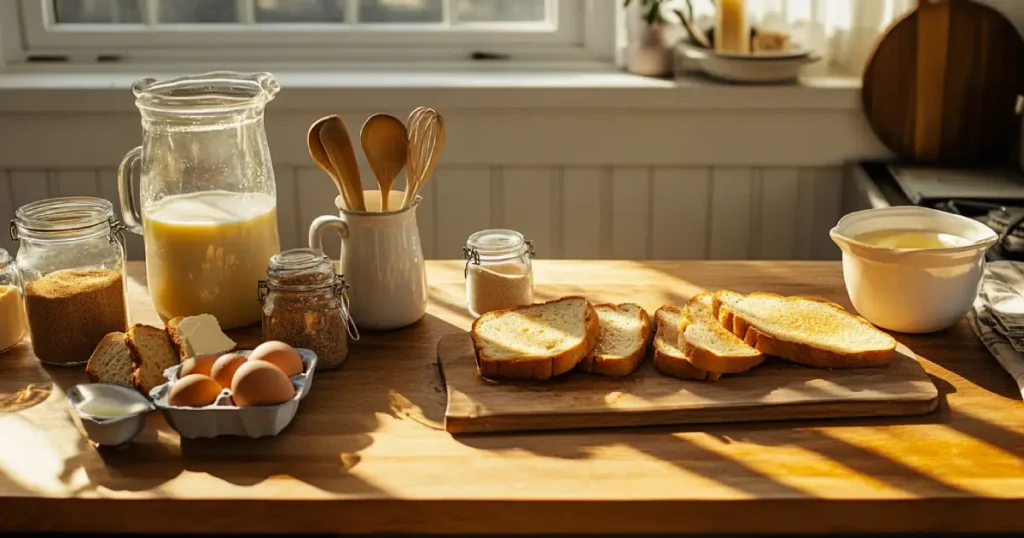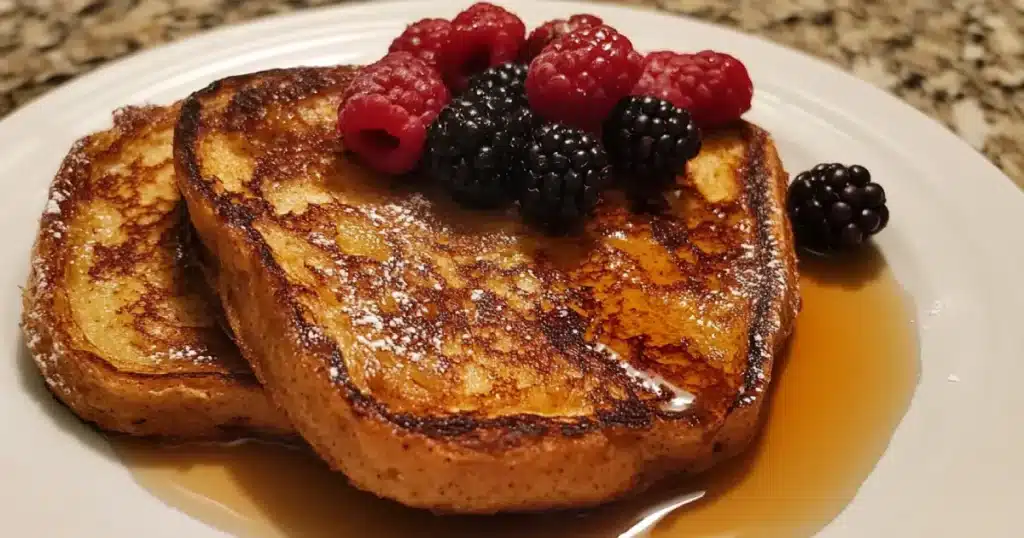Sourdough French toast is a delicious twist on the classic breakfast favorite. With its tangy flavor and hearty texture, sourdough bread transforms this dish into something extraordinary. Whether you’re a brunch enthusiast or someone looking to elevate their morning routine, this guide will walk you through everything you need to know about making perfect sourdough French toast. From selecting the right ingredients to serving suggestions, we’ll cover it all. Ready to dive into this irresistible breakfast? Let’s get started!
Outline
Introduction to Sourdough French Toast
What Makes Sourdough Unique?
Sourdough bread is special for many reasons. Unlike regular bread, it’s made with a natural fermentation process that creates its distinct tangy taste and chewy texture. The fermentation also makes sourdough easier to digest and packed with probiotics, giving it an edge over standard bread varieties. Its firm structure ensures it holds up beautifully when soaked in the custardy French toast batter, making it an ideal choice for this dish.
Why Sourdough Is Ideal for French Toast
When it comes to French toast, sourdough shines like no other bread. Thanks to its density and slightly crisp crust, it absorbs just the right amount of batter without falling apart. The subtle tang of sourdough complements the sweet and creamy flavors of the dish, creating a delightful balance. Moreover, its rustic look adds charm to your plate, making it Instagram-worthy for all the foodies out there.
This unique bread elevates French toast to new heights—making it an unmissable treat for breakfast or brunch. With the perfect combination of flavor, texture, and versatility, sourdough French toast is a must-try for anyone craving something special.
Ingredients and Equipment
Choosing the Right Sourdough Bread
The heart of sourdough French toast lies in the bread, so selecting the right loaf is essential. Opt for a loaf that’s slightly stale but not rock hard. Day-old sourdough is perfect as it holds up well during soaking without becoming overly mushy. Look for bread with a dense crumb and a sturdy crust for the best results. If possible, go for unsliced sourdough so you can cut thick, uniform slices—about 1-inch thick works best.
Essential Ingredients for Flavor

To create the ultimate sourdough French toast, you’ll need a handful of simple, yet important ingredients:
- Eggs: The foundation of the custard. Use large, fresh eggs for a rich and creamy texture.
- Milk or Cream: Adds moisture and richness. Whole milk or a mix of milk and cream works beautifully.
- Sweeteners and Spices: A splash of vanilla extract, a sprinkle of cinnamon, and a pinch of nutmeg enhance the flavor. Maple syrup or sugar adds just the right amount of sweetness.
- Butter: For frying, butter gives the French toast its golden-brown finish and a touch of indulgence.
Tools You’ll Need
Making sourdough French toast doesn’t require fancy gadgets, but a few tools make the process easier:
- A large mixing bowl for the batter.
- A whisk for smooth blending.
- A flat-bottomed skillet or griddle for even cooking.
- A spatula for flipping the toast without breaking it.
Step-by-Step Recipe for Sourdough French Toast
Preparing the Batter
Start by whisking together the eggs, milk (or cream), vanilla, and spices in a large bowl. Make sure the mixture is well-combined and slightly frothy. Add a touch of sugar or maple syrup if you prefer a sweeter French toast. This custard-like batter is the key to infusing flavor into the bread.
Soaking Sourdough Bread Properly
Once your batter is ready, it’s time to soak the bread. Dip each slice of sourdough into the mixture, allowing it to soak for 20–30 seconds on each side. Be careful not to over-soak—sourdough is absorbent, so it doesn’t take long to pick up enough liquid. Let the excess batter drip off before placing the slices on a plate.
Cooking to Perfection
Heat a skillet or griddle over medium heat and add a generous pat of butter. When the butter is melted and bubbling, place the soaked sourdough slices onto the hot surface. Cook for about 2–3 minutes on each side or until golden brown and slightly crisp around the edges. Flip gently with a spatula to avoid breaking the bread.
Serve your freshly cooked sourdough French toast immediately, or keep it warm in a low oven until ready to serve. The result? Perfectly golden slices with a crisp exterior and a soft, custardy center that’s bursting with flavor.
Sprinkle with powdered sugar, drizzle with maple syrup, or add your favorite toppings to make this breakfast truly unforgettable!
Enhancing Flavor: Variations and Add-ons
Sweet Variations: Maple, Cinnamon, and More
If you’re craving a sweeter version of sourdough French toast, there are countless ways to elevate its flavor. Start by adding extra cinnamon or a dash of ground cardamom to the batter for a warm, spicy kick. Drizzle the finished toast with real maple syrup or honey for a touch of natural sweetness. For a decadent treat, top with caramel sauce or a dollop of whipped cream. Fresh fruits like berries, bananas, or sliced apples pair beautifully with sourdough’s tangy flavor, adding a refreshing contrast.
Savory Twists: Herbs, Cheese, and Spices
Who says French toast has to be sweet? Turn your sourdough French toast into a savory delight by skipping the sugar and vanilla in the batter. Instead, mix in chopped herbs like chives or parsley and a pinch of black pepper. Sprinkle grated Parmesan or cheddar cheese over the bread as it cooks, creating a crispy, cheesy crust. A dash of smoked paprika or chili flakes adds a spicy twist that’s perfect for brunch or dinner.
Toppings to Elevate Your Dish
The right toppings can transform a good dish into an unforgettable one. For sweet versions, try a dusting of powdered sugar, crushed nuts, or a dollop of Greek yogurt. Savory variations shine with sliced avocado, a poached egg, or crispy bacon. The versatility of sourdough French toast means you can experiment endlessly to create your perfect bite.
For more delicious brunch ideas, check out sourdough cinnamon rolls on our website.
Nutritional Benefits and Tips for Healthy Options
Why Sourdough Is a Healthier Choice
Sourdough bread isn’t just delicious—it’s also a healthier option compared to other breads. Thanks to its fermentation process, sourdough is rich in probiotics, which promote gut health. It also has a lower glycemic index, meaning it won’t cause rapid spikes in blood sugar. When used in sourdough French toast, you’re enjoying a breakfast that’s both satisfying and nutritious.
How to Make French Toast with Less Sugar and Fat
Making sourdough French toast healthier is surprisingly simple. Substitute whole milk with almond milk or oat milk to cut calories while still achieving a creamy texture. Use a non-stick pan to reduce the amount of butter needed for cooking. For a naturally sweet flavor, mix mashed bananas into the batter instead of adding sugar.
Incorporating Seasonal Ingredients
Seasonal ingredients not only add fresh flavors but also increase the nutritional value of your dish. In the summer, top your French toast with fresh berries or peaches. During fall, add pumpkin puree to the batter or garnish with roasted nuts and a drizzle of maple syrup. Winter months are perfect for spiced apples or a sprinkle of pomegranate seeds.
By making these simple swaps and additions, you can enjoy the indulgence of sourdough French toast while keeping it balanced and wholesome.
Common Mistakes to Avoid
Avoiding Soggy French Toast
One common pitfall when making sourdough French toast is ending up with soggy slices. To avoid this, make sure you use slightly stale bread. Fresh sourdough is too soft and absorbs too much batter, leading to a mushy texture. Also, don’t over-soak the bread—20 to 30 seconds per side is plenty. For even better results, let the soaked slices rest for a few seconds before placing them on the skillet.
Ensuring Even Cooking
Uneven cooking can leave your French toast burnt on the outside but raw in the middle. To prevent this, preheat your skillet over medium heat and use a consistent cooking temperature. Too high, and the bread will scorch before the custard sets; too low, and it won’t cook through. Additionally, cook the slices in batches to avoid overcrowding the pan. Flip the bread gently with a spatula to keep it intact and ensure both sides cook evenly.
Choosing the Right Pan and Heat Settings
A good-quality non-stick skillet or griddle is your best friend for sourdough French toast. These pans distribute heat evenly, reducing the chances of burnt spots. Using medium heat allows the bread to cook through without charring. With these simple tips, you’ll avoid common mistakes and create beautifully golden slices every time.
Serving Suggestions and Pairings
Perfect Breakfast Combinations
Pairing sourdough French toast with other breakfast items can make your meal truly special. For a classic breakfast plate, serve it with crispy bacon or breakfast sausages. A side of scrambled eggs adds protein and balances the sweetness of the toast. Want something lighter? Fresh fruit like strawberries or melon is a great option.
Creative Brunch Presentation Ideas
Make your French toast the centerpiece of your brunch spread by adding creative touches. Arrange the slices in a fan shape on a platter, topped with a dusting of powdered sugar and a drizzle of syrup. Garnish with edible flowers or sprigs of fresh mint for an elegant touch. Individual servings with small bowls of assorted toppings, like berries, nuts, and whipped cream, encourage guests to personalize their plates.
Beverage Pairings for Sourdough French Toast
The right drink can elevate your sourdough French toast experience. For a cozy morning, pair it with a rich cappuccino or hot chocolate. If you’re hosting brunch, a mimosa or sparkling lemonade adds a festive flair. Prefer something refreshing? Iced tea or a fruit smoothie complements the dish beautifully.
FAQs
Does sourdough taste good for French toast?
Yes, sourdough bread tastes amazing in French toast! Its slightly tangy flavor pairs beautifully with the sweetness of the batter, creating a perfect balance of flavors. The firm texture of sourdough also makes it ideal for soaking up the custard without becoming soggy.
Is sourdough or brioche better for French toast?
Both breads have their strengths, and the choice depends on your preference. Brioche is rich, soft, and buttery, making it perfect for a decadent, dessert-like French toast. On the other hand, sourdough French toast offers a heartier texture and a tangy flavor that works well with both sweet and savory toppings. If you want something unique and versatile, sourdough is a fantastic choice.
What is the best bread for French toast?
The best bread for French toast is one that absorbs the custard well without falling apart. Sourdough, brioche, challah, and French baguette are all excellent options. Slightly stale bread works best, as it soaks up the batter evenly and holds its shape during cooking.
Does sourdough bread make good toast?
Absolutely! Sourdough bread makes fantastic toast. Its chewy interior and crisp crust become even more flavorful when toasted. Whether you top it with butter and jam, avocado, or eggs, sourdough toast is a versatile and delicious option for any meal.
In Closing
Sourdough French toast is more than just a breakfast staple—it’s a culinary experience that combines the rustic charm of sourdough bread with the comforting richness of classic French toast. Whether you’re enjoying a sweet version topped with fresh berries and syrup or a savory twist with herbs and cheese, the possibilities are endless.
By choosing the right bread, avoiding common mistakes, and experimenting with creative toppings and pairings, you can elevate this dish to suit any occasion. Plus, with its nutritional benefits and versatility, sourdough French toast is a treat you can feel good about serving.
So, why not give it a try? Gather your ingredients, fire up the skillet, and enjoy the delightful flavors of this timeless recipe. With each bite, you’ll discover why sourdough French toast is a favorite for breakfast, brunch, or even a cozy dinner. Happy cooking!




2 thoughts on “Sourdough French Toast Crispy, Soft, and Delicious!”